跨文化交际课文翻译
跨文化交际李成明unit2-A原文+翻译DOCX
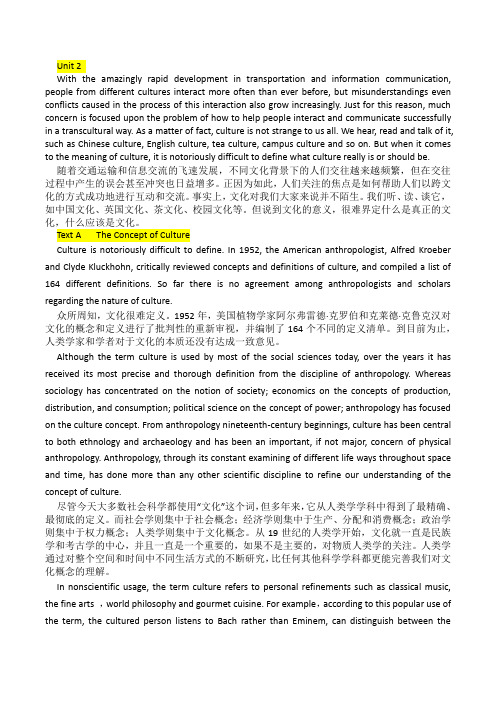
Unit 2With the amazingly rapid development in transportation and information communication, people from different cultures interact more often than ever before, but misunderstandings even conflicts caused in the process of this interaction also grow increasingly. Just for this reason, much concern is focused upon the problem of how to help people interact and communicate successfully in a transcultural way. As a matter of fact, culture is not strange to us all. We hear, read and talk of it, such as Chinese culture, English culture, tea culture, campus culture and so on. But when it comes to the meaning of culture, it is notoriously difficult to define what culture really is or should be.随着交通运输和信息交流的飞速发展,不同文化背景下的人们交往越来越频繁,但在交往过程中产生的误会甚至冲突也日益增多。
正因为如此,人们关注的焦点是如何帮助人们以跨文化的方式成功地进行互动和交流。
事实上,文化对我们大家来说并不陌生。
我们听、读、谈它,如中国文化、英国文化、茶文化、校园文化等。
新编跨文化交际【warm up】 原文及翻译
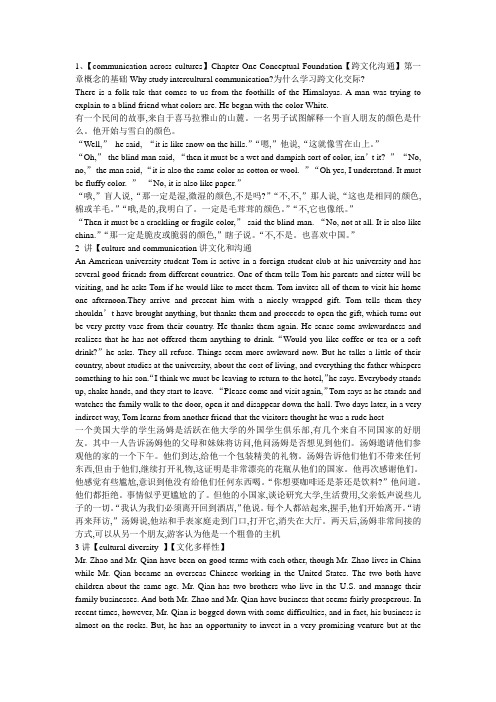
1、【communication across cultures】Chapter One Conceptual Foundation【跨文化沟通】第一章概念的基础Why study intercultural communication?为什么学习跨文化交际?There is a folk tale that comes to us from the foothills of the Himalayas. A man was trying to explain to a blind friend what colors are. He began with the color White.有一个民间的故事,来自于喜马拉雅山的山麓。
一名男子试图解释一个盲人朋友的颜色是什么。
他开始与雪白的颜色。
“Well,”he said, “it is like snow on the hills.”“嗯,”他说,“这就像雪在山上。
”“Oh,”the blind man said, “then it must be a wet and dampish sort of color, isn’t it? ”“No, no,”the man said, “it is also the same color as cotton or wool. ”“Oh yes, I understand. It must be fluffy color. ”“No, it is also like paper.”“哦,”盲人说,“那一定是湿,微湿的颜色,不是吗?”“不,不,”那人说,“这也是相同的颜色,棉或羊毛。
”“哦,是的,我明白了。
一定是毛茸茸的颜色。
”“不,它也像纸。
”“Then it must be a crackling or fragile color,”said the blind man. “No, not at all. It is also like china.”“那一定是脆皮或脆弱的颜色,”瞎子说。
跨文化交际Chapter 1部分翻译
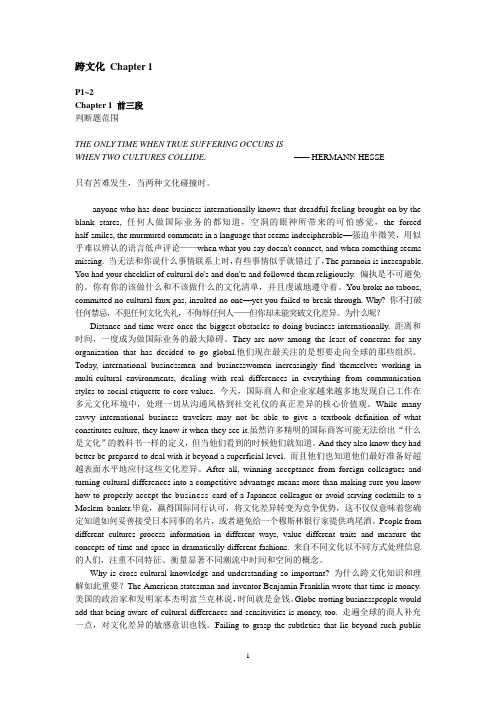
跨文化Chapter 1P1~2Chapter 1 前三段判断题范围THE ONLY TIME WHEN TRUE SUFFERING OCCURS ISWHEN TWO CULTURES COLLIDE. —— HERMANN HESSE只有苦难发生,当两种文化碰撞时。
anyone who has done business internationally knows that dreadful feeling brought on by the blank stares,任何人做国际业务的都知道,空洞的眼神所带来的可怕感觉,the forced half-smiles, the murmured comments in a language that seems indecipherable—强迫半微笑,用似乎难以辨认的语言低声评论——when what you say doesn't connect, and when something seems missing.当无法和你说什么事情联系上时,有些事情似乎就错过了,The paranoia is inescapable. You had your checklist of cultural do's and don'ts and followed them religiously.偏执是不可避免的。
你有你的该做什么和不该做什么的文化清单,并且虔诚地遵守着。
You broke no taboos, committed no cultural faux pas, insulted no one—yet you failed to break through. Why?你不打破任何禁忌,不犯任何文化失礼,不侮辱任何人——但你却未能突破文化差异。
为什么呢?Distance and time were once the biggest obstacles to doing business internationally.距离和时间,一度成为做国际业务的最大障碍。
跨文化交际中英文化对比课文参考译文U4
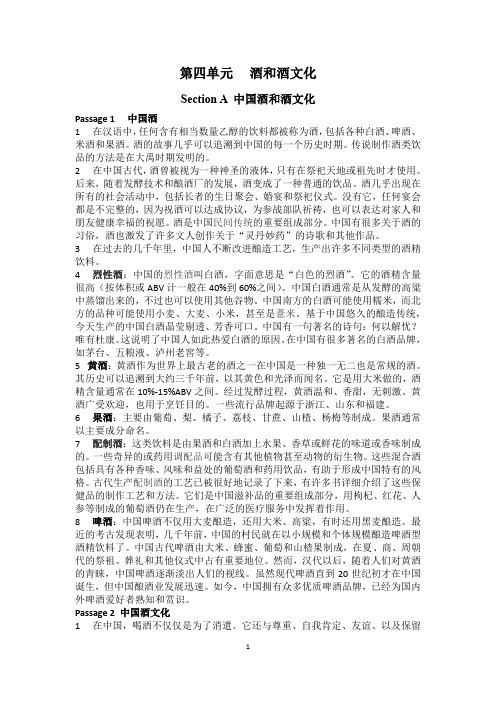
第四单元酒和酒文化Section A中国酒和酒文化Passage 1中国酒1在汉语中,任何含有相当数量乙醇的饮料都被称为酒,包括各种白酒、啤酒、米酒和果酒。
酒的故事几乎可以追溯到中国的每一个历史时期。
传说制作酒类饮品的方法是在大禹时期发明的。
2在中国古代,酒曾被视为一种神圣的液体,只有在祭祀天地或祖先时才使用。
后来,随着发酵技术和酿酒厂的发展,酒变成了一种普通的饮品。
酒几乎出现在所有的社会活动中,包括长者的生日聚会、婚宴和祭祀仪式。
没有它,任何宴会都是不完整的,因为祝酒可以达成协议,为参战部队祈祷,也可以表达对家人和朋友健康幸福的祝愿。
酒是中国民间传统的重要组成部分。
中国有很多关于酒的习俗,酒也激发了许多文人创作关于“灵丹妙药”的诗歌和其他作品。
3在过去的几千年里,中国人不断改进酿造工艺,生产出许多不同类型的酒精饮料。
4烈性酒:中国的烈性酒叫白酒,字面意思是“白色的烈酒”。
它的酒精含量很高(按体积或ABV计一般在40%到60%之间)。
中国白酒通常是从发酵的高粱中蒸馏出来的,不过也可以使用其他谷物。
中国南方的白酒可能使用糯米,而北方的品种可能使用小麦、大麦、小米,甚至是薏米。
基于中国悠久的酿造传统,今天生产的中国白酒晶莹剔透、芳香可口。
中国有一句著名的诗句:何以解忧?唯有杜康。
这说明了中国人如此热爱白酒的原因。
在中国有很多著名的白酒品牌,如茅台、五粮液、泸州老窖等。
5黄酒:黄酒作为世界上最古老的酒之一在中国是一种独一无二也是常规的酒。
其历史可以追溯到大约三千年前,以其黄色和光泽而闻名。
它是用大米做的,酒精含量通常在10%-15%ABV之间。
经过发酵过程,黄酒温和、香甜,无刺激。
黄酒广受欢迎,也用于烹饪目的。
一些流行品牌起源于浙江、山东和福建。
6果酒:主要由葡萄、梨、橘子、荔枝、甘蔗、山楂、杨梅等制成。
果酒通常以主要成分命名。
7配制酒:这类饮料是由果酒和白酒加上水果、香草或鲜花的味道或香味制成的。
一些奇异的或药用调配品可能含有其他植物甚至动物的衍生物。
跨文化交际中英文化对比课文参考译文U5

第五单元休闲饮品:茶和咖啡Section 中国的茶和茶文化Passage 1 中国的茶1 中国被称为茶之故乡。
传说神农曾经在一天之内中了72种毒草的毒,是茶发挥了解药的作用。
最新研究证明,中国是世界上最早生产茶叶的国家。
在中国,茶有时被用作药物。
从周代开始,茶从药变成了饮料,而饮茶在唐朝才成为风尚。
东汉著名内科和外科医生华佗说:“苦茶久食,益意思。
”茶圣陆羽写下了已知的世界上第一部茶专著《茶经》,详细记述了制茶、沏茶、饮茶以及其他的关于茶的知识。
对陆羽来说,茶象征着和谐和宇宙的神秘统一。
2 当今,茶在中国已经非常流行,即使是一顿便餐也会以一杯茶结束。
中国有句俗话说:“开门七件事,柴米油盐酱醋茶”。
但是,不同地区的人可能偏爱不同的茶。
从加工工艺来看,中国茶主要分为六类。
绿茶3 绿茶是最早的茶叶之一,以未发酵的茶叶为特征。
绿茶以其浓郁的香气、良好的口感和优雅的外形而闻名,并给人持久的力量感。
传统绿茶在国内外都很受欢迎。
著名的绿茶品种有西湖龙井、洞庭碧螺春、黄山毛峰、六安瓜片等。
乌龙茶4 乌龙茶,字面意思是黑龙茶,是一种介于绿茶和红茶之间的氧化茶。
乌龙茶的味道和红茶不同,更接近绿茶。
不具红茶的玫瑰、香甜味,但同样也没有绿茶特有的刺鼻的青草味。
乌龙茶被认为有助于脂肪分解,帮助减肥和保持健康。
这种茶一般沏成浓茶,回甘甜美。
乌龙茶通常受福建人和广东潮汕人偏爱。
大红袍、铁观音、冻顶乌龙茶是乌龙茶中的极品。
白茶5 白茶的特点是叶子几乎不经过氧化处理。
作为一种微发酵的茶,白茶具有淡淡的清香,冲泡时呈淡黄色。
白茶是用最新、最嫩、手工采摘的叶尖和芽制成的。
白茶是福建省的特产,是世界上最稀有、最壮观的茶叶之一。
白茶有着200多年的历史,它的发源地是福鼎市,那里种植着一种大叶型的茶树,叫做福鼎大白。
最受欢迎的白茶品种包括白毫银珍和白牡丹。
红茶6 红茶是一种比绿茶、乌龙茶和白茶氧化程度更高的茶。
一般来说,其味道比氧化程度低的茶更浓郁,含有更多的咖啡因。
跨文化交际中英文化对比课文参考译文U2

第二单元服饰和着装规范Section A 中国服饰Passage 1 中国传统服装1中国传统服饰是中国文化的重要组成部分,因为其历史反映了中国古代经济、政治、文化在不同历史阶段的变化。
2中国传统服装主要有两种款式:上衣下裳制和衣裳连属制。
上衣下裳制作为最早的服装式样可以追溯到黄帝时期。
这种服装是由上装“衣”和男女通用的下装“裳”组成的。
上衣下裳式服装流行于夏、商、周时期,其特点是左包右。
西周统治者以家族为基础,建立了以血缘和伦理规范为纽带的严格的等级制度。
正如这一时期出现的深衣和冕服所示,为了突出自己的特权,他们以服饰作为身份的象征。
3在春秋和战国时期,服装发生了很大的变化。
由于配有大腰带的宽松的服装已经不能跟上时代的步伐,服装界掀起了一场大变革。
为了提高部队的战斗力,赵武陵王提倡胡服。
胡服是由几件衣服组合而成的全套服装。
4一体式的袍是秦汉时期非常推崇的发款式。
秦朝规定三品及以上的官员穿绿袍和深衣,而普通人穿白袍。
在汉代,虽然深衣在汉人中间仍然很流行,但袍发挥着大礼服的作用。
汉服是从商朝的冕服演变而来的,随着宽袖的引入引入,汉服变得更加松散,还配有挂在腰带上的玉佩,以保持衣的合拢。
一套完整的汉服是由几件衣服组合而成的:衣(男女都可以穿的任何交领衣服)、袍(男性穿的任何封闭的全身衣)、襦(一种敞开的交领衫)、衫(一种敞开的交领衫或罩在衣之外的上衣)、裙或裳(一种中性裙子)和裤(裤子)。
5中国古代服饰的第二次大变化发生在魏晋南北朝时期。
原因是战事频频,款式稍有不同的胡服成为最常见的服装,其特点是袖子窄,衣贴身,裳开叉。
6隋唐时期,政治稳定,经济繁荣,是服装设计和款式发展的黄金时代,中外文化交流空前。
一套男性常服由幞头(软帽)或帽(硬帽)、罩衫和靴子组成的。
罩衫与裳稍有不同,圆领、无卷边窄袖,是胡服与汉服的完美结合。
唐代女性的服饰比前朝更为宽松和暴露,图案繁多。
7在理学的影响下,宋代的衣服在色彩上趋于保守,而袍逐渐被褙子取代。
大学英语跨文化交际教程翻译 杨晓萍 陶岳炼 主编
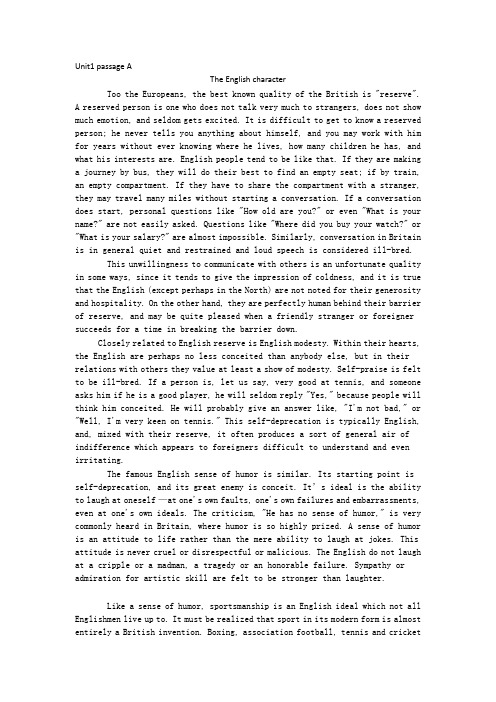
Unit1 passage AThe English characterToo the Europeans, the best known quality of the British is "reserve".A reserved person is one who does not talk very much to strangers, does not show much emotion, and seldom gets excited. It is difficult to get to know a reserved person; he never tells you anything about himself, and you may work with him for years without ever knowing where he lives, how many children he has, and what his interests are. English people tend to be like that. If they are making a journey by bus, they will do their best to find an empty seat; if by train, an empty compartment. If they have to share the compartment with a stranger, they may travel many miles without starting a conversation. If a conversation does start, personal questions like "How old are you?" or even "What is your name?" are not easily asked. Questions like "Where did you buy your watch?" or "What is your salary?" are almost impossible. Similarly, conversation in Britain is in general quiet and restrained and loud speech is considered ill-bred.This unwillingness to communicate with others is an unfortunate quality in some ways, since it tends to give the impression of coldness, and it is true that the English (except perhaps in the North) are not noted for their generosity and hospitality. On the other hand, they are perfectly human behind their barrier of reserve, and may be quite pleased when a friendly stranger or foreigner succeeds for a time in breaking the barrier down.Closely related to English reserve is English modesty. Within their hearts, the English are perhaps no less conceited than anybody else, but in their relations with others they value at least a show of modesty. Self-praise is felt to be ill-bred. If a person is, let us say, very good at tennis, and someone asks him if he is a good player, he will seldom reply "Yes," because people will think him conceited. He will probably give an answer like, "I'm not bad," or "Well, I'm very keen on tennis." This self-deprecation is typically English, and, mixed with their reserve, it often produces a sort of general air of indifference which appears to foreigners difficult to understand and even irritating.The famous English sense of humor is similar. Its starting point is self-deprecation, and its great enemy is conceit. It’s ideal is the ability to laugh at oneself —at one's own faults, one's own failures and embarrassments, even at one's own ideals. The criticism, "He has no sense of humor," is very commonly heard in Britain, where humor is so highly prized. A sense of humor is an attitude to life rather than the mere ability to laugh at jokes. This attitude is never cruel or disrespectful or malicious. The English do not laugh at a cripple or a madman, a tragedy or an honorable failure. Sympathy or admiration for artistic skill are felt to be stronger than laughter.Like a sense of humor, sportsmanship is an English ideal which not all Englishmen live up to. It must be realized that sport in its modern form is almost entirely a British invention. Boxing, association football, tennis and cricketwere all first organized and given rules in Britain. Rules are the essence of sport, and sportsmanship is the ability to practise a sport in obedience to its rules, while also showing generosity to one's opponent and good temper in defeat. Moreover, sportsmanship as an ideal is applied to life in general. One of the most elementary rules of life is "never hit a man when he's down"─in other words, never take advantage of another person's misfortune. English school-boys often show this sense of sportsmanship to a surprisingly high degree in their relations with each other.译文:对于其他欧洲人来说,英国人最著名的特点是“谨慎”。
跨文化交际_Unit_2_参考翻译

跨文化交际_Unit_2_参考翻译Unit Two Task 11)A smooth sea never made a skillful mariner. 平静的大海决不能造就出熟练的水手。
/花盆里生长不出参天大树。
/温室里长不出栋梁之才。
2)He who would search for pearls must dive below.不入虎穴,焉得虎子。
/ 欲寻珍珠就要潜到水里。
/ 欲寻珍珠欲潜入水。
3)Living without an aim is like sailing without a compass. 生活没有目标如同航行没有罗盘。
/没有目标的生活如同没有罗盘的航行。
4)To have another fish to fry另有要事/ 另有事情得做5)The water that bears the boat is the same that swallows it up.水能载舟,亦能覆舟。
(The same knife cuts bread and fingers.)6)前人栽树,后人乘凉。
One sows and another reaps. / One man sows and another reaps. / One generation plants the trees in whose shade another generation rests. / The precedence planted, the later generations enjoy its cool.7)斩草不除根,逢春又发青。
If the grass is only cut, then the next spring it will revive. / Cut weeds and dig up the roots.8)种田不用问,深耕多上粪。
Planting has no better measures but ploughing deeply and fertilizing much more.9)生米煮成熟饭。
新编跨文化交际英语教程课文翻译

新编跨文化交际英语教程课文翻译本页仅作为文档封面,使用时可以删除This document is for reference only-rar21year.MarchU1reading1跨文化交际日益引起人们的注意的原因:是由于交通工具的进步与通讯手段的发展使得不同国家、不同种族、不同民族的人能够频繁地接触和交往。
L.S.Harms认为,在世界范围内的交际经历了五个阶段:A语言的产生; B文字的使用; C印刷技术的发明; D近百年交通工具的进步和通讯手段的迅速发展; E跨文化交际。
近二十年来的交际是以跨文化为特征的。
二、对跨文化交际的不同理解有的人认为每个人在文化上都是独特的,所以任何两个人之间的交际都是跨文化交际。
文化通常不是指个人的行为,而是指一个群体的生活方式和习惯。
作者认为作跨国、跨种族、跨民族.研究不仅应该是跨文化交际研究包括的内容,而且应该是放在首位的。
在研究一个国家的文化特点时,我们的眼光首先应集中在它的主流文化上,其次才注意它的亚文化和地区文化的特点含义:人们应用符号并借助媒介交流信息的行为与过程;人与人之间直接交往活动;通过媒介进行的信息交流与沟通活动。
人类传播的发展:信息符号传播:手势、有限的声音、体语符号、其它符号、实物口语传播媒介传播传播类型:非人类传播与人类传播伴随人类产生发生出现;不同民族相互接触与融洽的结果;交通和通讯工具的发展促进跨文化交际的发展含义:具有不同文化背景的人们之间进行的交际往来或信息传播与沟通活动文化在跨文化交际中的地位:是跨文化交际的核心;文化的复杂性影响跨文化研究;文化涵盖历史与现实、实物与制度及观念、稳定性与能动性、群体特点与地区及个体差异影响跨文化交际的主要因素:民族的历史与传统、宗教思想、价值观念、社会组织形式、风俗习惯、政治制度、社会发展阶段case1主角被埃及人邀请去家里吃丰盛的大餐,他用餐后说食物很好。
在这种情况下,理查德错误可能是他选择赞美食物本身,而不是整个晚上,的食物。
跨文化交际课文翻译
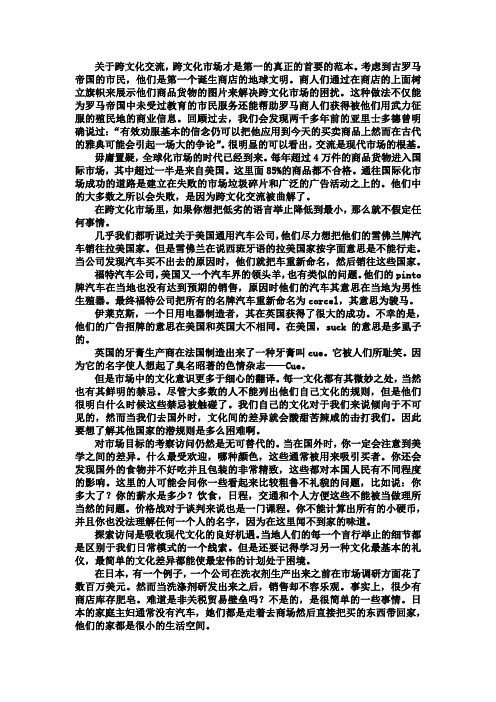
关于跨文化交流,跨文化市场才是第一的真正的首要的范本。
考虑到古罗马帝国的市民,他们是第一个诞生商店的地球文明。
商人们通过在商店的上面树立旗帜来展示他们商品货物的图片来解决跨文化市场的困扰。
这种做法不仅能为罗马帝国中未受过教育的市民服务还能帮助罗马商人们获得被他们用武力征服的殖民地的商业信息。
回顾过去,我们会发现两千多年前的亚里士多德曾明确说过:“有效劝服基本的信念仍可以把他应用到今天的买卖商品上然而在古代的雅典可能会引起一场大的争论”。
很明显的可以看出,交流是现代市场的根基。
毋庸置疑,全球化市场的时代已经到来。
每年超过4万件的商品货物进入国际市场,其中超过一半是来自美国。
这里面85%的商品都不合格。
通往国际化市场成功的道路是建立在失败的市场垃圾碎片和广泛的广告活动之上的。
他们中的大多数之所以会失败,是因为跨文化交流被曲解了。
在跨文化市场里,如果你想把低劣的语言举止降低到最小,那么就不假定任何事情。
几乎我们都听说过关于美国通用汽车公司,他们尽力想把他们的雪佛兰牌汽车销往拉美国家。
但是雪佛兰在说西班牙语的拉美国家按字面意思是不能行走。
当公司发现汽车买不出去的原因时,他们就把车重新命名,然后销往这些国家。
福特汽车公司,美国又一个汽车界的领头羊,也有类似的问题。
他们的pinto 牌汽车在当地也没有达到预期的销售,原因时他们的汽车其意思在当地为男性生殖器。
最终福特公司把所有的名牌汽车重新命名为corcel,其意思为骏马。
伊莱克斯,一个日用电器制造者,其在英国获得了很大的成功。
不幸的是,他们的广告招牌的意思在美国和英国大不相同。
在美国,suck的意思是多虱子的。
英国的牙膏生产商在法国制造出来了一种牙膏叫cue。
它被人们所耻笑。
因为它的名字使人想起了臭名昭著的色情杂志——Cue。
但是市场中的文化意识更多于细心的翻译。
每一文化都有其微妙之处,当然也有其鲜明的禁忌。
尽管大多数的人不能列出他们自己文化的规则,但是他们很明白什么时候这些禁忌被触碰了。
大学英语跨文化交际U5课文翻译、词汇、习语整理

Unit 5Nonverbal communication课前谚语+名言:1、I’s not what he said, but the way he said it.——English saying2、There is a language in her eyes, her cheeks, her lips.——William Shakespeare案例一:个人空间马克最近从丹麦搬到了悉尼,在一家澳大利亚公司当销售员。
他被邀请加入当地的一个俱乐部。
有一天在一个晚会上,一个女成员走近他,马克立即通过谈论展现出了他的兴趣。
起初聊天进行的很顺利,但随着谈话的进行,马克逐渐的向她靠近,而那位女士似乎离他越来越远,并显得很不自在。
当马克正要问她有关于澳大利亚习俗的问题时,站在旁边的一个男士往这边瞟了一眼,她找了个借口离开,去和那个男人说话。
留下马克傻傻的站在那里,他不知道为什么他们的交谈如此突然地停止了。
Question:Why did that women suddenly stop talking with mark and turned to another man?注释:这是一个对身体距离理解不同造成的误会。
在丹麦,正式场合中,个人空间大概在20厘米-30厘米之间。
而在澳大利亚,这样的场合需要40厘米-50厘米的身体距离。
所以丹麦人习惯近距离交谈,澳大利亚人习惯远距离交谈。
在这个情况下,马克尝试去建立自己正常的个人亲密空间,侵犯了澳大利亚女士的空间,正因如此,她感到了某种威胁,失去了舒适感。
就在那时,身旁的男人给了她一个离开的机会。
如果马克对于澳大利亚人所期待的个人空间有所了解的话,或许这个谈话会有所不同。
案例二:使用当地语言的问题。
弗兰克为了做研究的目的从澳大利亚来到中国,为此,他在大学里刻苦学习中文,并且能用中文很方便的和人交流。
而当他到达北京以后,他开始和当地人交谈,询问方向和建议。
尽管他几乎都是用中文和他们交流,但是他发现周围的人有时候会笑着用英语回答他,尽管他们对英语知之甚少。
新编跨文化交际【warm up】 原文及翻译

1、【communication across cultures】Chapter One Conceptual Foundation【跨文化沟通】第一章概念的基础Why study intercultural communication?为什么学习跨文化交际?There is a folk tale that comes to us from the foothills of the Himalayas. A man was trying to explain to a blind friend what colors are. He began with the color White.有一个民间的故事,来自于喜马拉雅山的山麓。
一名男子试图解释一个盲人朋友的颜色是什么。
他开始与雪白的颜色。
“Well,”he said, “it is like snow on the hills.”“嗯,”他说,“这就像雪在山上。
”“Oh,”the blind man said, “then it must be a wet and dampish sort of color, isn’t it? ”“No, no,”the man said, “it is also the same color as cotton or wool. ”“Oh yes, I understand. It must be fluffy color. ”“No, it is also like paper.”“哦,”盲人说,“那一定是湿,微湿的颜色,不是吗?”“不,不,”那人说,“这也是相同的颜色,棉或羊毛。
”“哦,是的,我明白了。
一定是毛茸茸的颜色。
”“不,它也像纸。
”“Then it must be a crackling or fragile color,”said the blind man. “No, not at all. It is also like china.”“那一定是脆皮或脆弱的颜色,”瞎子说。
跨文化交际英语阅读教程4课文翻译 (2)

跨文化交际英语阅读教程4课文翻译第一课:文化差异与交际文化差异的定义文化差异是指不同国家或地区之间的历史、地理、宗教、经济等方面的差异。
这些差异会影响到人们的价值观、信仰、行为习惯、社会组织形式等。
在跨文化交际中,了解和尊重文化差异非常重要。
文化差异对交际的影响文化差异对交际有着深远的影响。
不同文化背景的人在沟通交流中可能会遇到以下问题: 1. 语言障碍:不同国家和地区使用不同的语言,理解和表达存在障碍。
2. 非语言符号的差异:不同国家和地区的非语言符号(如手势、表情、礼仪等)可能有不同的含义,容易引发误解。
3. 礼貌和礼仪的差异:不同文化对礼貌和礼仪的要求有所不同,可能会造成交际上的尴尬和冲突。
4. 价值观的冲突:不同文化对价值观的理解和认同也存在差异,可能会引发理念上的冲突。
跨文化交际的技巧为了更好地进行跨文化交流,以下是一些技巧: 1. 学习对方的语言:学习对方的语言可以加深理解,减少语言障碍。
2. 了解对方的文化:了解对方的文化背景、价值观念和行为习惯,增进理解和尊重。
3. 尊重对方的非语言符号:避免使用可能被对方误解的非语言符号,尊重对方的习俗和文化。
4. 灵活调整自己的礼貌和礼仪:在不同文化背景下,灵活调整自己的礼貌和礼仪,以尊重对方的文化。
5. 接纳不同的价值观:不同文化的人们对于相同事物的看法可能存在差异,要学会接纳并理解对方的价值观。
第二课:文化沟通中的误解和解决高、低沟通语境的差异高沟通语境的文化中,人们通过非语言符号、隐含的信息和环境背景来传递信息;低沟通语境的文化中,人们更加注重直接明确的信息。
了解和适应不同的沟通语境是避免误解的关键。
文化差异引发的误解1.时间观念:在一些高度重视时间效率的文化中,迟到被视为不尊重;而在某些文化中,迟到是普遍存在的现象。
2.礼貌和直接表达:一些文化注重礼节和婉转的表达方式,而另一些文化更加注重直接坦率的交流。
3.非语言符号:不同文化的手势、表情、身体接触等非语言符号可能有不同的含义,可能会引发误解。
跨文化交际_Unit_2_参考翻译

Unit Two Task 11)A smooth sea never made a skillful mariner. 平静的大海决不能造就出熟练的水手。
/花盆里生长不出参天大树。
/温室里长不出栋梁之才。
2)He who would search for pearls must dive below.不入虎穴,焉得虎子。
/ 欲寻珍珠就要潜到水里。
/ 欲寻珍珠欲潜入水。
3)Living without an aim is like sailing without a compass. 生活没有目标如同航行没有罗盘。
/没有目标的生活如同没有罗盘的航行。
4)To have another fish to fry另有要事/ 另有事情得做5)The water that bears the boat is the same that swallows it up.水能载舟,亦能覆舟。
(The same knife cuts bread and fingers.)6)前人栽树,后人乘凉。
One sows and another reaps. / One man sows and another reaps. / One generation plants the trees in whose shade another generation rests. / The precedence planted, the later generations enjoy its cool.7)斩草不除根,逢春又发青。
If the grass is only cut, then the next spring it will revive. / Cut weeds and dig up the roots.8)种田不用问,深耕多上粪。
Planting has no better measures but ploughing deeply and fertilizing much more.9)生米煮成熟饭。
跨文化交际英语阅读教程所学课文翻译
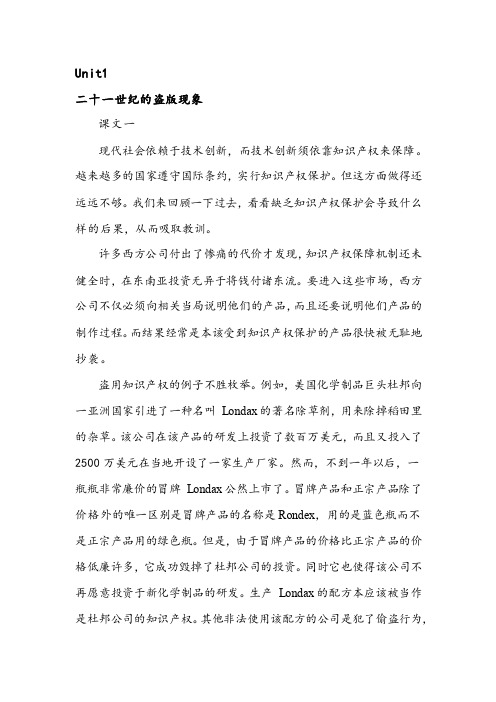
Unit1二十一世纪的盗版现象课文一现代社会依赖于技术创新,而技术创新须依靠知识产权来保障。
越来越多的国家遵守国际条约,实行知识产权保护。
但这方面做得还远远不够。
我们来回顾一下过去,看看缺乏知识产权保护会导致什么样的后果,从而吸取教训。
许多西方公司付出了惨痛的代价才发现,知识产权保障机制还未健全时,在东南亚投资无异于将钱付诸东流。
要进入这些市场,西方公司不仅必须向相关当局说明他们的产品,而且还要说明他们产品的制作过程。
而结果经常是本该受到知识产权保护的产品很快被无耻地抄袭。
盗用知识产权的例子不胜枚举。
例如,美国化学制品巨头杜邦向一亚洲国家引进了一种名叫Londax的著名除草剂,用来除掉稻田里的杂草。
该公司在该产品的研发上投资了数百万美元,而且又投入了2500万美元在当地开设了一家生产厂家。
然而,不到一年以后,一瓶瓶非常廉价的冒牌Londax公然上市了。
冒牌产品和正宗产品除了价格外的唯一区别是冒牌产品的名称是Rondex,用的是蓝色瓶而不是正宗产品用的绿色瓶。
但是,由于冒牌产品的价格比正宗产品的价格低廉许多,它成功毁掉了杜邦公司的投资。
同时它也使得该公司不再愿意投资于新化学制品的研发。
生产Londax的配方本应该被当作是杜邦公司的知识产权。
其他非法使用该配方的公司是犯了偷盗行为,就像盗取了杜邦公司的机器或者该公司的其他财产一样。
不光是产品,在亚洲市场上保护一个品牌也曾经是几乎不可能的事。
就连Kellogg’s玉米片的生产商Kellogg’s公司也发现自己的产品被山寨:Kongal 牌玉米条,连包装也几乎一模一样。
不幸的是,和杜邦公司的事件一样,Kellogg’s 公司成功惩罚侵权者的几率几乎为零,因为当地的法律不承认知识产权保护的概念。
幸好,在经过许多轮世贸组织的谈判后,情况大为改观。
然而,跨国公司必须保持警惕,以防被侵权。
总有人试图从别人的研发、投资、商誉中牟利。
如果成果得不到法律保护,创新就是空话。
跨文化交际中英文化对比课文参考译文U1
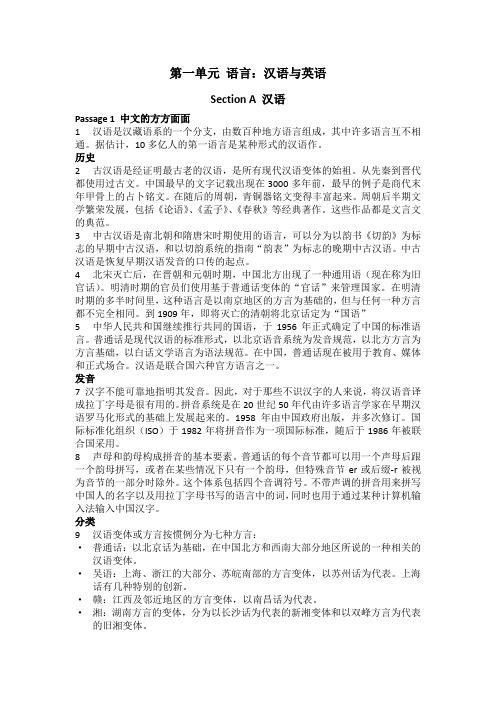
第一单元语言:汉语与英语Section A 汉语Passage 1 中文的方方面面1汉语是汉藏语系的一个分支,由数百种地方语言组成,其中许多语言互不相通。
据估计,10多亿人的第一语言是某种形式的汉语作。
历史2古汉语是经证明最古老的汉语,是所有现代汉语变体的始祖。
从先秦到晋代都使用过古文。
中国最早的文字记载出现在3000多年前,最早的例子是商代末年甲骨上的占卜铭文。
在随后的周朝,青铜器铭文变得丰富起来。
周朝后半期文学繁荣发展,包括《论语》、《孟子》、《春秋》等经典著作。
这些作品都是文言文的典范。
3中古汉语是南北朝和隋唐宋时期使用的语言,可以分为以韵书《切韵》为标志的早期中古汉语,和以切韵系统的指南“韵表”为标志的晚期中古汉语。
中古汉语是恢复早期汉语发音的口传的起点。
4北宋灭亡后,在晋朝和元朝时期,中国北方出现了一种通用语(现在称为旧官话)。
明清时期的官员们使用基于普通话变体的“官话”来管理国家。
在明清时期的多半时间里,这种语言是以南京地区的方言为基础的,但与任何一种方言都不完全相同。
到1909年,即将灭亡的清朝将北京话定为“国语”5中华人民共和国继续推行共同的国语,于1956年正式确定了中国的标准语言。
普通话是现代汉语的标准形式,以北京语音系统为发音规范,以北方方言为方言基础,以白话文学语言为语法规范。
在中国,普通话现在被用于教育、媒体和正式场合。
汉语是联合国六种官方语言之一。
发音7 汉字不能可靠地指明其发音。
因此,对于那些不识汉字的人来说,将汉语音译成拉丁字母是很有用的。
拼音系统是在20世纪50年代由许多语言学家在早期汉语罗马化形式的基础上发展起来的。
1958年由中国政府出版,并多次修订。
国际标准化组织(ISO)于1982年将拼音作为一项国际标准,随后于1986年被联合国采用。
8声母和韵母构成拼音的基本要素。
普通话的每个音节都可以用一个声母后跟一个韵母拼写,或者在某些情况下只有一个韵母,但特殊音节er或后缀-r被视为音节的一部分时除外。
跨文化交际课后翻译原文1--8单元

Translation1The growth of intercultural communication as a field of study is based on a view of history that clearly demonstrates people and cultures have been troubled by a persistent inability to understand and get along with groups and societies removed by space, ideology, appearance, and behavior from their own. What is intriguing about many of human civilization’s failure is that they appear to be personal as well as global. The story of humankind is punctuated with instances of face-to-face conflicts as well as international misunderstanding--major and minor quarrels that range from simple name-calling to isolationism tr even armed conflict. It is obvious that increases contact with other cultures and subcultures make it imperative for us to make a concerted effort to understand and get along with people whose beliefs and backgrounds may be vastly different from our own. The ability, through increased awareness and understanding, to peacefully coexist with people who do not necessarily share our lifestyles or values could benefit us not only in our own neighborhoods but could be the decisive factor in maintaining would peace. Translation 2Culture is something referred to as our mental programming, our “software of the mind.”But we can take that computer analogy further and say that culture is the operating environment that enables software programs to run. Culture is like DOS or Unix or Windows:it is what enables us to process information in various specific applications. The metaphor of windows seems to be very appealing to describe culture:culture is a mental set of windows through which all of life is viewed. It varies from individual to individual within a society, but it shares important characteristics with members of a society. Culture is like the water fish swim in--a reality that is taken for granted and rarely examined. It is in the air we breathe and is as necessary to our understanding of who we are as air is to our physical life. Culture is the property of a community people, not simply a characteristic of individuals. Societies are programmed by culture, and that programming comes from similar life experiences and similar interpretations of what those experiences mean. If culture is mental programming, it is also a mental map of reality. It tells us from early childhood what matters, what o prefer, what to avoid, and what to do. Culture also tells us what ought to be . It gives us assumptions about the ideal beyond what individuals may experience. It helps us in setting priorities. It establishes codes for behavior and provides justification and legitimization for that behavior.Translation 3Although each of us has a unique set of values, there also are values that tend to permeate a culture. These are called cultural values. Cultural values generally are normative in that they inform a member of a culture what is good and bad, right and false, positive and negative, and the like. Cultural values define what is worthwhile to die for, what is worth protecting, what frightens people and their social systems, what are considered proper subjects for study and for ridicule, and what types of events lead individuals to group solidarity. Cultural values also specify what behaviors are of importance and which should be avoided within a culture. Values represent a learned organization of rules for making choices and for resolving conflicts. The values held by participants in intercultural communication are important because values develop standards and guidelines that establish appropriate and inappropriate behaviors in a society. V alues, in other words, help determine how people ought to behave with the result that people will exhibit and expect behaviors according to their value systems. To the extent that cultural value systems differ, we may expect that intercultural communication participants will tend to exhibit and to expect different under similar circumstance.Translation 4When we say that language is always ambiguous, what we mean is that we can never fully control the meaning of the things we say and write. The meanings we exchange by speaking and by writing are not given in the words and sentences alone but are also constructed partly out of what our listeners and our readers interpret them to mean. To put this quite another way, meaning in language is jointly constructed by the participants in communication. Language is inherently ambiguous. It means that in order to communicate we must always jump to conclusions about what other mean. There is no way around this. When someone says something, w must jump to some conclusion about what he or she means. We draw inferences based on two main sources. 1, the language they have used, and 2, our knowledge about the world. The knowledge includes expectations about what people would normally say in such circumstances. Language is ambiguous. This means that we can never be certain what the other person means--whether in speaking or writing. To put it another way, language can never fully express our meanings. But what does this mean for intercultural communication? In the first place it should be clear that communication works better the more the participants share assumptions and knowledge about the world. Where two people have very similar histories, backgrounds, and experiences, their communication works fairly easily because the inferences each makes about what the other means will be based on common experience and knowledge. Two people from the same village and the same family are likely to make fewer mistakes in drawing inferences about what the other means than two people from different cities on different sides of the earth.Translation 5Where any two people differ in group membership because they are of different genders, different ages, different ethnic or culture groups, different educations, different parts of the same country or even city, different income or occupational groups, or with very different personal histories, each will find it more difficult to draw inferences about what the other person means.In the contemporary world of international and intercultural communication, the differences between people are considerable. People are in daily contact with members of cultures and other groups from all around the world. Successful communication is based on sharing as much as possible the assumptions we make about what others mean. When we are communicating with people who are very different from us, it is very difficult to know how ti draw inferences about what they mean, and so it is impossible to depend on shared knowledge and background for confidence in our interpretation.It has been found that men and women from the same culture, even from the sane families, often misunderstand each other because of different assumptions they make about the purposes or goals of their communication. A man may wish to make a woman happy by giving her a gift of something she really wants. He asks her what she would like to have for her birthday--- she can ask for anything. Unfortunately, what she wants more than anything else is for him to know intuitively what she would like to have. Men and women, at least in North American society, tend to differ in their concern for explicitness or for indirection. A woman is likely to think it is important for someone to show how well he knows her by not having to ask explicitly what she wants. A man in that situation, however, feels beast about the situation if he is told quiet directly and explicitly how he can make her happy.Translation 6Non-verbal communication might be thought of as any form of communication which is not directly dependent on the use of language. Generally speaking, however, it is very difficult to know where to separate verbal and non-verbal forms of communication. Such non-verbal aspects of communication as nodding the head most often accompany speech and are part and parcel of the verbal system of language use. On the other hand such forms of communication as dance and music often have no verbal component at all. What we want to here is simply to call attention to the fact that many aspects of human interaction depend upon forms of communication which can not be easily transcribed into words and yet are crucial to our understanding to each other.Of course we have to emphasize the importance of communication in speaking and writing, and yet we should also realize that much much communication also takes place without the use of words. The way a person dresses for a meeting may suggestion to other participants how he or she is prepared to participate in it. In fact, we can use virtually any aspect of our behavior or our presentation which others can perceive as means of communication.Translation 7Many people today want to do many things within so little time. The sense o time might be called time urgency, it is a syndrome of behavior in which the persons continually tries to accomplish more than can be humanly accomplished. Until very recently, time urgency was thought to be a characteristics of Americans, particularly American males in the generation born in the period from the Great Depression through to the end of the World War .It should be obvious that that this sense of time urgency is no longer a cultural characteristic of just this one generation of American males. It is a characteristic of the Asian “salary man”, and is spreading throughout the world rapidly as one aspect of the internationalization of business.One of the most important effects of this sense of time is that in communication it will almost produce a negative evaluation to the slower participants by the faster participants. Those who share in this concept of time urgency will come to see anyone who moves more slowly than they do as conservative, as uncooperative, as resistant to change, and as opposing progress. Behind the concept of time urgency is the idea that what lies ahead in the future is always better than what lies behind in the past; it based solidly on the belief in progress.Translation 8If we accept the belief that our past influences our view of reality and the corresponding tenet that each of us may have similar but not identical personal histories, then it should follow that another person’s picture of the universe will not be exactly like ours. Y et most of us act as if our way of perceiving things is the correct and only way. We often overwork perceptual differences and conclude that if the other person doesn’t see that Pablo Picasso is the greatest artist that ever lived, he simply does not art. Actually, it may well be that he has a different past history and what is great art for him may not match our perception of art.In our daily activities these differences in perception appear between different groups. V arious generations, minorities, occupation and cultures have conflicting values and goals that will influence their orientation and interpretation of reality.Our culture is a major of factor in perceptual discrepancies. Culture helps supply us with our perceptive of reality. It therefore plays a dominant role in intercultural communication. Our cultures tell us, in a variety of ways, how to judge others and what to use as criteria for those judgments. The danger of such evaluations is that they are often false, misleading, and arbitrary. It is truly a naive view of the world to believe and behave as if we an our culture have discovered the true and only set of norms.。
新编跨文化交际英语教程1-6单元翻译(Word可编辑版)

纵观历史,我们可以清楚地看到,人们由于彼此所处地域、意识形态、容貌服饰和行为举止上存在的差异,而长久无法互相理解、无法和睦相处。
在这种情况下,跨文化交际作为一个特定的研究领域得以形成和发展。
值得注意的是, 人类文明在发展过程中所遭受的许多挫折, 既是个人的, 又是全球性的: 人类历史进程总是充满了个人问的直接冲突和民族间的误解一一从骂骂咧咧到孤立主义直至到武装冲突, 大大小小争端不绝。
很显然, 文化间以及亚文化问的交往比以前多了, 这迫切要求我们共同努力, 去理解有着不同信仰和文化背景的人们, 并与之和睦相处。
通过加深认识和理解, 我们能够与生活方式、价值观念不同的人们和平共处: 这不但有益于我们周遭环境的安定, 也是维护世界和平的决定性因素。
Translation Unit 2文化有时候被称为我们的心智程序, 我们“头脑的软件”。
但是, 我们可以进一步引中这个用电脑所做的类比, 把文化看作是支持运行的操作环境。
文化就像电脑使用的Dos 或者unix 或者“视窗”(windows) 等操作系统一样, 使我们能在各种各样的实际应用中处理信息。
用“视窗”这个比喻来描述文化似乎也很有吸引力。
文化就是我们心灵的视窗,透过它我们审视生活的方方面面。
一个社会中不同个体的视窗是不大一样的, 但都有着一些重要的共同特征。
文化就好像是鱼畅游于其中的水一般, 人们想当然地把文化看成是客观存在的事实, 因而很少去研究它。
文化存在于我们所呼吸的空气之中, 文化对于我们了解我们自身之为何物是必不可少的, 就正如生命离不开空气一样。
文化是特定群体的共有财产, 而不单是个体的特征。
社会按照文化设定的程序运作, 这种程序来自于相似的生活体验以及对这种生活体验之含义的相似阐释。
如果文化是一种心智程序, 那么它也是现实的心灵地图。
从我们很小的时候开始, 文化就告诉我们应该看重什么、偏好什么、规避什么和做些什么, 文化还告诉我们事物应该是什么样。
跨文化交际三篇重点范围内的英语课文文章翻译

Speaking English with a Japanese mind 日本人在达到上学年龄后就要学英语,这些人在学会英语之后就可能用英语进行对外交流,但是他们所使用的英语要受到他们本民族的语言和文化的影响。
因此这就会造成困扰和误解在与其他用英语的人交流时。
AM,当他作为索尼公司的首席执行官时,在一次给美国的商学会做报告时他指出了这两种语言的明显差异。
他举了一个例子,一个美国商人向他的一个日本生意上的伙伴提议了一项计划。
可是当美国人完成时,日本人才开始谈论这个项目听起来多么有趣并且他们公司也有同样的想法。
美国人认为这个项目肯定会被接受。
但是随着辩论的拖延,美国人的关注也开始减弱,然后日本人说,不管怎样。
AM告诫说,接下来就是你要仔细听的时候了。
因为真正的回答是在那个词语的后面。
他经常告诫他的部下官员要用一种大多数的使用英语的人都习惯的方式说话,如果他想被别人理解。
他还告诫说,在日本你可能是大多数,但是到了国外你就是一小部分。
要想用一种大多数人都能最大限度的理解你的方式说话需要更多的语法知识和大量的词汇。
你必须对你所谈话的那个人的交流方式,社交礼仪,价值观等等很熟悉。
日本人的说话顺序正好和说英语的人相反。
甚至就是一个非常简单的句子,比如英国人会说,你得带伞因为要下雨。
而日本人会说,因为会下雨所以你要带伞。
不管这种正常的表达方式的顺序是否会控制想法顺序还是什么,日本人这种用不同顺序的表达信息的方式会让那些说英语的国家的人且对日本语言不了解的人感到困惑。
另一个例子就是,一些说英语的日本人和美国的一些领导举行卫星电视会议来讨论两国间的经济和贸易关系。
日本的参会者说着流利的英语,同时会被翻译成日语以供那些不懂得英语的人理解。
美国人,当然了,说的话也要被翻译成日语。
然而,对于那些想听到用原汁原味的讨论的人来说,多路传输声音系统提供了条件。
在讨论期间,一个美国人问道汇率的变化是否会导致美元的贬值进而严重影响到日本对美国的出口呢。
- 1、下载文档前请自行甄别文档内容的完整性,平台不提供额外的编辑、内容补充、找答案等附加服务。
- 2、"仅部分预览"的文档,不可在线预览部分如存在完整性等问题,可反馈申请退款(可完整预览的文档不适用该条件!)。
- 3、如文档侵犯您的权益,请联系客服反馈,我们会尽快为您处理(人工客服工作时间:9:00-18:30)。
关于跨文化交流,跨文化市场才是第一的真正的首要的范本。
考虑到古罗马帝国的市民,他们是第一个诞生商店的地球文明。
商人们通过在商店的上面树立旗帜来展示他们商品货物的图片来解决跨文化市场的困扰。
这种做法不仅能为罗马帝国中未受过教育的市民服务还能帮助罗马商人们获得被他们用武力征服的殖民地的商业信息。
回顾过去,我们会发现两千多年前的亚里士多德曾明确说过:“有效劝服基本的信念仍可以把他应用到今天的买卖商品上然而在古代的雅典可能会引起一场大的争论”。
很明显的可以看出,交流是现代市场的根基。
毋庸置疑,全球化市场的时代已经到来。
每年超过4万件的商品货物进入国际市场,其中超过一半是来自美国。
这里面85%的商品都不合格。
通往国际化市场成功的道路是建立在失败的市场垃圾碎片和广泛的广告活动之上的。
他们中的大多数之所以会失败,是因为跨文化交流被曲解了。
在跨文化市场里,如果你想把低劣的语言举止降低到最小,那么就不假定任何事情。
几乎我们都听说过关于美国通用汽车公司,他们尽力想把他们的雪佛兰牌汽车销往拉美国家。
但是雪佛兰在说西班牙语的拉美国家按字面意思是不能行走。
当公司发现汽车买不出去的原因时,他们就把车重新命名,然后销往这些国家。
福特汽车公司,美国又一个汽车界的领头羊,也有类似的问题。
他们的pinto 牌汽车在当地也没有达到预期的销售,原因时他们的汽车其意思在当地为男性生殖器。
最终福特公司把所有的名牌汽车重新命名为corcel,其意思为骏马。
伊莱克斯,一个日用电器制造者,其在英国获得了很大的成功。
不幸的是,他们的广告招牌的意思在美国和英国大不相同。
在美国,suck的意思是多虱子的。
英国的牙膏生产商在法国制造出来了一种牙膏叫cue。
它被人们所耻笑。
因为它的名字使人想起了臭名昭著的色情杂志——Cue。
但是市场中的文化意识更多于细心的翻译。
每一文化都有其微妙之处,当然也有其鲜明的禁忌。
尽管大多数的人不能列出他们自己文化的规则,但是他们很明白什么时候这些禁忌被触碰了。
我们自己的文化对于我们来说倾向于不可见的,然而当我们去国外时,文化间的差异就会酸甜苦辣咸的击打我们。
因此要想了解其他国家的潜规则是多么困难啊。
对市场目标的考察访问仍然是无可替代的。
当在国外时,你一定会注意到美学之间的差异。
什么最受欢迎,哪种颜色,这些通常被用来吸引买者。
你还会发现国外的食物并不好吃并且包装的非常精致,这些都对本国人民有不同程度的影响。
这里的人可能会问你一些看起来比较粗鲁不礼貌的问题,比如说:你多大了?你的薪水是多少?饮食,日程,交通和个人方便这些不能被当做理所当然的问题。
价格战对于谈判来说也是一门课程。
你不能计算出所有的小硬币,并且你也没法理解任何一个人的名字,因为在这里闻不到家的味道。
探索访问是吸收现代文化的良好机遇。
当地人们的每一个言行举止的细节都是区别于我们日常模式的一个线索。
但是还要记得学习另一种文化最基本的礼仪,最简单的文化差异都能使最宏伟的计划处于困境。
在日本,有一个例子,一个公司在洗衣剂生产出来之前在市场调研方面花了数百万美元。
然而当洗涤剂研发出来之后,销售却不容乐观。
事实上,很少有商店库存肥皂。
难道是非关税贸易壁垒吗?不是的,是很简单的一些事情。
日本的家庭主妇通常没有汽车,她们都是走着去商场然后直接把买的东西带回家,他们的家都是很小的生活空间。
文化因子影响着买卖行为。
这些因子包括区域,迷信,家庭结构,烹饪,语言和当地历史。
目标语言很容易被确定。
但是考虑到概括性,西班牙的西班牙语和拉美国家的西班牙语也不一样。
我们应经知道光是在中国就有一万多种方言。
而且也应该认识到旧的符号汉字在新加坡和其它国家以及其它地区仍然用着。
而这些旧体字在中国已经被简体字所取代。
大部分50岁以下的大陆人都不认得旧体字的书写。
错综复杂的迷信和语言的效应被放大化了。
在中国和日本,数字4有着相同的发音意思着死亡,因此,四分之一的公司名称和合同信息可能有消极的含义。
而数字8被认为是幸运的数字,并且很多商品以88和888命名。
电话号码含数字8的预示着好的命运,这种信念如此流行以至于在香港的医院里到处都是1988年8月8号邻近产期的妈妈,他们要求人工引产或者是剖腹产,目的是为了让自己的小孩有一个幸运的生日。
在中国的日历上1988年也是龙年的吉祥年。
作为美国人,我们经常进入到有竞争力的行业中,在那里我们不时的我们自己,我们的公司,和我们的商品进行比较。
但是在欧盟和亚洲的一些国家,广告中的比较时不允许的。
对于欧盟里面的活动,吹捧你的商品的优点价值是可以的,但是对于美国,运用比较的策略是行不通的。
在一些地方,和美国人的鲁莽行事相比,他们那的市民更倾向于谦虚。
许多文化对强调公司的长期性和名誉反应良好。
如果你正在设计可视广告,要考虑到无声言行举止中的地区差别,比如说姿势,个人空间,男女之间的关系。
很多年以前,在中国放映了一部电影,这种接吻戏在一些国家也曾经播放过。
当那对夫妻的嘴唇碰在一起时,一阵急促的喘息声弥漫了整个剧院。
基于各种各样的因素,当众接吻的这种高震撼行为对你的广告可能起有利或有害的效应。
假定一个亚洲或者拉美或者欧洲消费者那将是一个大的错误。
此外,国家间的边界并不总是能够刻画出买卖举止的。
地区性模式还是很明显的。
最好的就是有一个有着目标文化的本民族知识的人来说服你,小的预算,可以去咨询商会来寻求有效的帮助。
但是在出台一项市场决策之前,首先进行市场测验,通常是在一个国家或地区的主要城市展开。
一般来说,城市人口更复杂并且其态度观点更广泛。
他们也有最高的收入,因此他们更有能力抓住消费者和他们想要得到的货物。
在这样的预测下,一个美国箱包制造商发现文化也会影响想法和感知力。
这个公司设计了一种新的围绕着行李的展开翅膀的图像的广告活动。
但是很多阿拉伯人认为他们是在为那个商标做广告。
要想在国际化市场中取得成功,一个人需要有个人阅历并且能够分辨出他或她自己的文化中的感性的东西。
一个人需要意识到交流的方式和个人处理信息的方式因文化而迥异,像举止,价值观和感知力。
